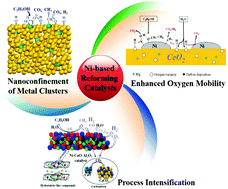Strategies for improving the performance and stability of Ni-based catalysts for reforming reactions
Abstract
Owing to the considerable publicity that has been given to petroleum related economic, environmental, and political problems, renewed attention has been focused on the development of highly efficient and stable catalytic materials for the production of chemical/fuel from renewable resources. Supported nickel nanoclusters are widely used for catalytic reforming reactions, which are key processes for generating synthetic gas and/or hydrogen. New challenges were brought out by the extension of feedstock from hydrocarbons to oxygenates derivable from biomass, which could minimize the environmental impact of carbonaceous fuels and allow a smooth transition from fossil fuels to a sustainable energy economy. This tutorial review describes the recent efforts made toward the development of nickel-based catalysts for the production of hydrogen from oxygenated hydrocarbons via steam reforming reactions. In general, three challenges facing the design of Ni catalysts should be addressed. Nickel nanoclusters are apt to sinter under catalytic reforming conditions of high temperatures and in the presence of steam. Severe carbon deposition could also be observed on the catalyst if the surface carbon species adsorbed on metal surface are not removed in time. Additionally, the production of hydrogen rich gas with a low concentration of CO is a challenge using nickel catalysts, which are not so active in the water gas shift reaction. Accordingly, three strategies were presented to address these challenges. First, the methodologies for the preparation of highly dispersed nickel catalysts with strong metal–support interaction were discussed. A second approach—the promotion in the mobility of the surface oxygen—is favored for the yield of desired products while promoting the removal of surface carbon deposition. Finally, the process intensification via the in situ absorption of CO2 could produce a hydrogen rich gas with low CO concentration. These approaches could also guide the design of other types of heterogeneous base-metal catalysts for high temperature processes including methanation, dry reforming, and hydrocarbon combustion.


 Please wait while we load your content...
Please wait while we load your content...